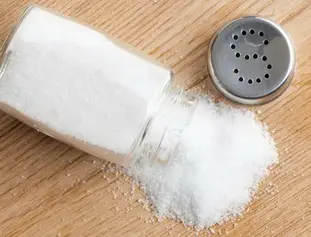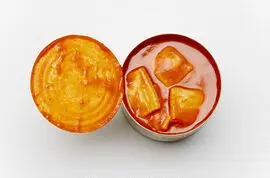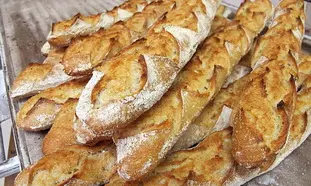This site uses only a few technical cookies necessary for its operation. By continuing to browse, you accept their use.
To find out more...
To find out more...
Let's go easy on the salt

In terms of cooking, I'm probably not teaching you much, salt is ubiquitous, we put it in almost all our dishes, in varying amounts depending on our taste, some like salty, others less, others still not. Its main role is the flavor, the taste, we say that it is a flavor enhancer, ie it reveals the tastes of food, especially if they are a bit bland by nature.
8,635 4.8/5 (19 reviews)
Keywords for this post:SaltHealthExcessWHOLimitationReductionLast modified on: February 20th 2021
Let's go easy on the salt
In other words, a dish that is not salty is much less tasty than a salty dish, and as a result, it is, for many (and I am the first), difficult to do without it.
But there are 2 salts, the one you add while cooking, or by spreading with semi-salted butter, according to your taste, and especially the one you don't see or don't feel, the hidden salt. And to illustrate this, I will take 2 concrete examples:
So when you heat up a simple box of ravioli, you will eat too much salt without realizing it, and as a recent study by "Que choisir" shows, it's even worse for anything that seems cheap, the less expensive the product is, the more salt it contains, so that the manufacturer can mask the poor quality of its ingredients.
But let's go back to salt, in France, the usual use (but it is not regulated, for the moment), is 18 gr of salt per kilo of flour. This is relatively little, to compare 50 years ago it was 24 gr, or even more!
The trend is clearly downwards, and the bakery industry is pushing for a reduction to 16 or 14 g, or even less.
Moreover, there is a simple phenomenon linked to slow bread-making: the longer the dough rests and ferments, the less salt it needs. And so the express baguettes from the supermarkets or bread factories, imagine what they load in salt to try to sell you something that has a vague taste.
Don't hesitate to ask your baker, ask him how much salt he uses per kilo of flour? If he's a good baker, not only will he give you a straight answer, but he'll also be able to give you his personal perspective on this delicate subject. By the way, our Belgian friends have a maximum of 14g.
Then, when we cook, we must try to avoid having a heavy hand in salt with extremely simple tricks too: always taste before re(salting), prefer spices to salt when possible, do not "double" that is to say for example do not salt a dressing, because it is already salty with the addition of mustard, no or little salt if you put cheese in your recipe, etc.
Nothing revolutionary in all this you will have understood, you just have to be a little careful, read carefully the labels of what you buy, and especially... cook as much as possible!
To sum up: Let's go easy on the salt, it's a matter of our health.

But there are 2 salts, the one you add while cooking, or by spreading with semi-salted butter, according to your taste, and especially the one you don't see or don't feel, the hidden salt. And to illustrate this, I will take 2 concrete examples:
Ready-made meals
The industrialists of the food industry have found in salt their best friend, not only they raise the taste as I told you previously, but moreover it acts as a water retainer, so everything that contains water, almost everything in fact, is generally very or too salty. Tragically, there is a lot of it everywhere, in all ready-made meals, cold cuts, snacks... even sweet foods (creams, desserts, biscuits, etc. etc.) contain it.
So when you heat up a simple box of ravioli, you will eat too much salt without realizing it, and as a recent study by "Que choisir" shows, it's even worse for anything that seems cheap, the less expensive the product is, the more salt it contains, so that the manufacturer can mask the poor quality of its ingredients.
Bread
In bread, there is also salt, bread is extremely simple: water, flour, a little salt and yeast or leaven, period! Everything else, as JP Coffe rightly said, is crap, just there to compensate for the deficiencies of industrial bread.
But let's go back to salt, in France, the usual use (but it is not regulated, for the moment), is 18 gr of salt per kilo of flour. This is relatively little, to compare 50 years ago it was 24 gr, or even more!
The trend is clearly downwards, and the bakery industry is pushing for a reduction to 16 or 14 g, or even less.
Moreover, there is a simple phenomenon linked to slow bread-making: the longer the dough rests and ferments, the less salt it needs. And so the express baguettes from the supermarkets or bread factories, imagine what they load in salt to try to sell you something that has a vague taste.
Don't hesitate to ask your baker, ask him how much salt he uses per kilo of flour? If he's a good baker, not only will he give you a straight answer, but he'll also be able to give you his personal perspective on this delicate subject. By the way, our Belgian friends have a maximum of 14g.
And so?
The observation is without appeal, we eat too much salt, we should be at 5 gr/day maximum according to the WHO, and we are rather at 10/15 gr in France.What can we do?
The solution is almost too simple: first of all, we must try to limit all ready-made products, which is often easier said than done. Let's see this as a strong signal to push us to cook more and more ourselves, by transforming the products we buy locally. The virtuous circle I've already told you a lot about (yes, it's my hobby): we buy local even if it's a bit more expensive, we support local producers, they produce well and healthily, it's good for our health, everyone wins.Then, when we cook, we must try to avoid having a heavy hand in salt with extremely simple tricks too: always taste before re(salting), prefer spices to salt when possible, do not "double" that is to say for example do not salt a dressing, because it is already salty with the addition of mustard, no or little salt if you put cheese in your recipe, etc.

Nothing revolutionary in all this you will have understood, you just have to be a little careful, read carefully the labels of what you buy, and especially... cook as much as possible!
To sum up: Let's go easy on the salt, it's a matter of our health.
Lasts posts
Butter vs. grease
We often read in a recipe where a pastry is put into a mould that, just before pouring, the mould should be buttered or greased. But what's the difference between these 2 terms?December 1st 20251,2235
Getting out of the fridge early
Very often when you're cooking, you need to take food or preparations out of the fridge, to use them in the recipe in progress. There's nothing tricky about this: you just take them out of the fridge and use them, usually immediately, in the recipe. But is this really a good method?November 24th 20251,2125
Who's making the croissants?
When you look at a bakery from the outside, you naturally think that in the bakery, the bakers make the bread, and in the laboratory, the pastry chefs make the cakes. It's very often like that, with each of these professions having quite different ways of working, but sometimes there's also one...November 23th 20251,106
Oven height
When we put a dish or cake in the oven, we naturally tend to put it on the middle shelf, and that's what we usually do. But in some cases, this position and height can be a little tricky, so let's find out why.October 8th 20253,0225
The importance of sieving
In recipes that use a fine powder (flour, powdered sugar, etc.), you'll often see the advice to sift before using it. To sift is to pass the powder in question through a sieve (a very fine strainer) before incorporating it into your recipe. It's often advice, but is it really useful?September 3rd 20257,7193
Other pages you may also like
Unmoulding cakes while hot
When you make a cake, pound cake or whatever (what bakers call a "travel cake" because it's easy to carry around) you've most likely made a batter, either by hand or in a food processor, which you then pour into a buttered pan. It's a classic, and I've already talked to you about 2 or 3 tips on...February 6th 202139 K4.6
The "caves" in the bakery and pastry shop
Maybe you've already done this? You want to make a brioche or a cake with fruit inside, you decide to proceed with your usual recipe, but also to add in the dough pieces of fresh and raw fruit, or whole fruit, for example pieces of apples or pears, good idea. When you bake it, everything seems to...March 27th 202112 K4.9
A stable cutting board
As soon as you have something to cut in the kitchen, the best thing to do is to use a cutting board, it protects your table or work surface, and their material is made to protect the edge of your knife, that is to say that it is soft enough, in short it is the ideal thing. But simply put on the...May 22th 20219,5545
Incise some meats before cooking
Have you ever had this rather unpleasant phenomenon: you grill a meat, a pork chop or a veal cutlet for example, and during cooking it becomes completely deformed? It takes a very strange shape, a bit difficult to describe, a sort of cone around the central area of the meat, which also hinders...June 19th 202112 K4.9
Cooking scallops
We are, as I write these lines, in the season of the scallops, if you like that it is necessary to benefit from it as much as possible, although it is alas not cheap. I like scallops a lot, but I have to admit that it has naturally little taste, or, said differently, it takes the taste of what...November 23th 202113 K5
Post a comment or question
Follow this page
If you are interested in this page, you can "follow" it, by entering your email address here. You will then receive a notification immediately each time the page is modified or a new comment is added. Please note that you will need to confirm this following.
Note: We'll never share your e-mail address with anyone else.
Alternatively: you can subscribe to the mailing list of cooling-ez.com , you will receive a e-mail for each new recipe published on the site.









